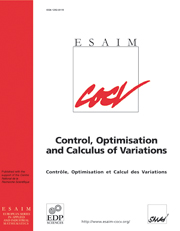Crossref Citations
This article has been cited by the following publications. This list is generated based on data provided by
Crossref.
Tucsnak, Marius
and
Weiss, George
2003.
How to Get a Conservative Well-Posed Linear System Out of Thin Air. Part II. Controllability and Stability.
SIAM Journal on Control and Optimization,
Vol. 42,
Issue. 3,
p.
907.
Jacob, Birgit
and
Partington, Jonathan R.
2004.
Current Trends in Operator Theory and its Applications.
p.
199.
Matignon, Denis
and
Prieur, Christophe
2005.
Asymptotic stability of linear conservative systems when coupled with diffusive systems.
ESAIM: Control, Optimisation and Calculus of Variations,
Vol. 11,
Issue. 3,
p.
487.
Malinen, J.
2005.
Conservativity and Time-Flow Invertibility of Boundary Control Systems.
p.
5953.
Guo, Bao-Zhu
and
Shao, Zhi-Chao
2005.
Regularity of a Schrödinger equation with Dirichlet control and colocated observation.
Systems & Control Letters,
Vol. 54,
Issue. 11,
p.
1135.
Arov, D.Z.
and
Staffans, O.J.
2005.
The Infinite-Dimensional Continuous Time Kalman–Yakubovich–Popov Inequality.
p.
5947.
Jacob, B.
and
Morris, K.
2005.
Minimum-Phase Infinite-Dimensional SISO Second-Order Systems.
p.
410.
Jacob, Birgit
Morris, Kirsten
and
Trunk, Carsten
2006.
Minimum‐Phase Second‐Order Systems and the Spectrum of the Semigroup Generator.
PAMM,
Vol. 6,
Issue. 1,
p.
631.
Guo, Bao-Zhu
and
Shao, Zhi-Chao
2006.
Regularity of an Euler-Bernoulli Equation with Neumann Control and Collocated Observation.
Journal of Dynamical and Control Systems,
Vol. 12,
Issue. 3,
p.
405.
Curtain, Ruth F.
and
Weiss, George
2006.
Exponential stabilization of well-posed systems by colocated feedback.
SIAM Journal on Control and Optimization,
Vol. 45,
Issue. 1,
p.
273.
A. Demetriou, Michael
and
Fahroo, Fariba
2006.
Model reference adaptive control of structurally perturbed second‐order distributed parameter systems.
International Journal of Robust and Nonlinear Control,
Vol. 16,
Issue. 16,
p.
773.
Malinen, Jarmo
and
Staffans, Olof J.
2006.
Conservative boundary control systems.
Journal of Differential Equations,
Vol. 231,
Issue. 1,
p.
290.
Malinen, Jarmo
Staffans, Olof
and
Weiss, George
2006.
When is a linear system conservative?.
Quarterly of Applied Mathematics,
Vol. 64,
Issue. 1,
p.
61.
Yao, Peng-Fei
2007.
Global smooth solutions for the quasilinear wave equation with boundary dissipation.
Journal of Differential Equations,
Vol. 241,
Issue. 1,
p.
62.
Yao, Peng‐Fei
and
Weiss, George
2007.
Global Smooth Solutions and Exponential Stability for a Nonlinear Beam.
SIAM Journal on Control and Optimization,
Vol. 45,
Issue. 6,
p.
1931.
Z. Arov, Damir
and
J. Staffans, Olof
2007.
State/signal linear time‐invariant systems theory: passive discrete time systems.
International Journal of Robust and Nonlinear Control,
Vol. 17,
Issue. 5-6,
p.
497.
Ammari, K.
Tucsnak, M.
and
Tenenbaum, G.
2007.
Control of Coupled Partial Differential Equations.
Vol. 155,
Issue. ,
p.
1.
Havu, V.
and
Malinen, J.
2007.
The Cayley Transform as a Time Discretization Scheme.
Numerical Functional Analysis and Optimization,
Vol. 28,
Issue. 7-8,
p.
825.
Arov, Damir Z.
and
Staffans, Olof J.
2007.
The Extended Field of Operator Theory.
Vol. 171,
Issue. ,
p.
37.
Hao, Jianghao
and
Li, Shengjia
2007.
Global solutions and blow-up solutions for a nonlinear string with boundary input and output.
Nonlinear Analysis: Theory, Methods & Applications,
Vol. 66,
Issue. 1,
p.
131.
 to another Hilbertspace U. We prove that the system of equations $$\ddot z(t)+A_0 z(t) + {\frac{1}{2}}C_0^*C_0\dot z(t) =C_0^*u(t) $$
to another Hilbertspace U. We prove that the system of equations $$\ddot z(t)+A_0 z(t) + {\frac{1}{2}}C_0^*C_0\dot z(t) =C_0^*u(t) $$  $$y(t) =-C_0 \dot z(t)+u(t),$$
$$y(t) =-C_0 \dot z(t)+u(t),$$  determines a well-posed linear system with input u and output y.The state of this system is $$x(t) = \left[\begin{matrix}\, z(t) \\ \dot z(t)\end{matrix}\right] \in{\cal D}\left(A_0^{\frac{1}{2}}\right)\times H = X ,$$
determines a well-posed linear system with input u and output y.The state of this system is $$x(t) = \left[\begin{matrix}\, z(t) \\ \dot z(t)\end{matrix}\right] \in{\cal D}\left(A_0^{\frac{1}{2}}\right)\times H = X ,$$  where X is the state space. Moreover, we have the energy identity $$\|x(t)\|^2_X-\|x(0)\|_X^2 =\int_0^T\| u(t)\|^2_U {\rm d}t - \int_0^T \|y(t)\|_U^2 {\rm d}t.$$
where X is the state space. Moreover, we have the energy identity $$\|x(t)\|^2_X-\|x(0)\|_X^2 =\int_0^T\| u(t)\|^2_U {\rm d}t - \int_0^T \|y(t)\|_U^2 {\rm d}t.$$  We show that the system described above is isomorphic to its dual, sothat a similar energy identity holds also for the dual system andhence, the system is conservative. We derive various other propertiesof such systems and we give a relevant example: a wave equation on abounded n-dimensional domain with boundary control and boundaryobservation on part of the boundary.
We show that the system described above is isomorphic to its dual, sothat a similar energy identity holds also for the dual system andhence, the system is conservative. We derive various other propertiesof such systems and we give a relevant example: a wave equation on abounded n-dimensional domain with boundary control and boundaryobservation on part of the boundary.
